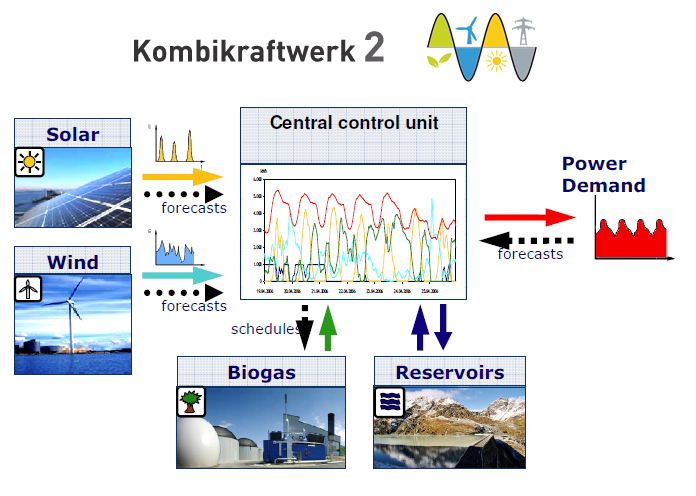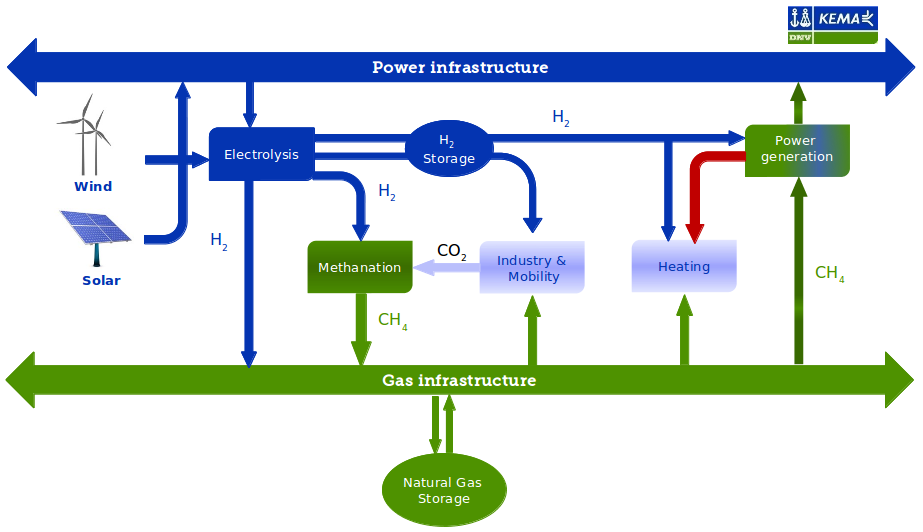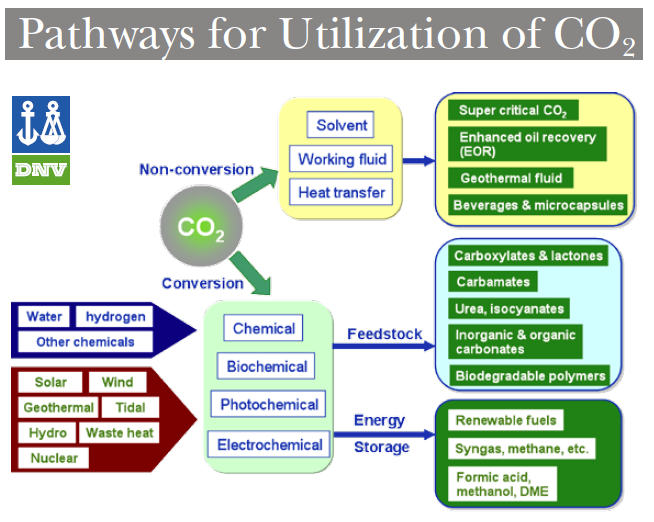Published at The Energy Collective, Dec. 9, 2013
Wind, solar and biogas combine to keep the lights on in Germany
In Germany a test has been successfully conducted of a 100% renewable energy power plant using wind, solar and biogas to provide round the clock electric power. The Kombikraftwerk 2 is a “Combined Renewable Energy Power Plant” that links together geographically dispersed assets into a virtual power plant. Unlike plans for 100% renewable energy written by activists such as Mark Jacobson that are designed to influence the political debate but could never actually function, this plan is designed by engineers to actually work in the real world. Many climate activists reject all carbon based fuels but the Germans recognize the crucial role played by methane as a renewable that can both fill in for the intermittency of wind and solar as well as providing much needed energy storage. This novel new renewable energy model demonstrates the need for natural gas backup, energy storage in the gas pipeline network, carbon capture and utilization and renewable natural gas.
The Kombikraftwerk 2 is a pilot study funded by the German government and conducted by a consortium of leading companies including Siemens and SMA along with academics and the weather service. The main focus of the study was to demonstrate on live facilities that grid stability could be maintained as the power outputs from wind and solar fluctuated. Through a combination of slight curtailment and biogas power, precise voltages and frequencies were successfully maintained on the power grid. The test system linked together 37 wind turbines, four biogas CHP plants, twelve PV systems and one pumped hydro reservoir into a virtual 80 MW plant intended to meet the power demand of one small town or equivalently 1/10,000th of Germany’s overall power demand. All of the plants were active commercial facilities. Most of the documentation for the project is in German, but here are links to English videos and papers. The videos provide an excellent overview of the operations and a vision for how the system is meant to work in the future including the advanced power to gas systems.
In America the discussion over energy storage is generally focused on batteries or pumped hydro. The Department of Energy lists batteries, flywheels, capacitors, control systems and some others technologies in its Energy Storage Program, but no mention is made of using the natural gas pipelines as a storage medium. The Germans on the other hand embrace the idea of power to gas completely and lead the world in the technology. Power to gas plays an important but often overlooked role in the Energiewende. Power to gas offers substantial benefits in minimizing curtailment when wind and hydro are overpowered by using the diverse, abundant, long-term storage capacity of the pipeline networks. There are real limitations in batteries and pumped hydro, aside from their expense, they can only store a few hours of power, these technologies have their role but neither can offer the massive storage potential of the gas pipeline network that is already in place. Gas pipelines also offer alternative long distance transport options to the power grid that is less expensive and lower impact than power lines.
Power to gas works in a variety of ways. The simplest method is basic electrolysis; electric power is used to separate water into hydrogen and oxygen. The hydrogen can then be used directly, injected in small quantities directly into the natural gas pipelines or combined with carbon to form methane. Pilot projects are currently being run in Germany to assess direct injection of hydrogen. A more advanced option is to combine hydrogen with CO2 captured from coal or other fossil fuels to form methane, which is CH4. This process requires some energy to break apart the carbon bonds, but it would be done with surplus or low cost power.
Making use of captured CO2 is a topic rarely mentioned in the American policy debates. The discussion is dominated by Carbon Capture and Sequestration (CCS) and how difficult and expensive it is. Carbon Capture and Utilization (CCU) offers an alternative model for carbon recycling. Using low cost power from surplus renewables or nuclear, CO2 can be broken apart and used for fuels or in the chemical industry. Methane is not the only option and other chemicals may offer better economics or efficiencies. An interesting study was performed by DNV and can be found here. The main products that can be produced from CO2 include chemicals, plastics, carbon fiber, graphene, fuels, carbonated beverages and Enhanced Oil Recovery (EOR). EOR has been the most successful use so far for CCS, but sequestering CO2 just to produce more fossil fuels does seem to defeat the purpose from a climate change perspective. CCU is an idea that should be explored far more actively in this country as carbon is valuable life giving molecule, not toxic waste.
While I am personally very excited to see this concept of a gas-electric renewable power model brought to life, I do have a couple of comments about the limitations of the Kombikraftwerk.
First, this model is for electricity only, they state in the video that “most” transportation will be electric, but obviously not all. Electricity is great for light duty passenger vehicles and commuter trains, but hydrocarbons are still needed for heavy duty and long distance vehicles such as trucks, construction equipment, airplanes and ships (Rod Adams passionate appeal for nuclear shipping duly noted). Clean fuels for transportation are still needed and not provided for in this model.
Secondly this model is not a prescription for a high energy future. This model presumes (without saying) that energy use will be reduced through efficiency measures, which may be possible but it is not clear that it is desirable. The production of wind, solar and biomass simply do not add up to provide the massive quantities of energy that will be required to lift billions of people out of poverty. Bulk heat and power in a high energy future will need to be provided by nuclear power and on this point I break with German energy policy. A high energy future opens up new possibilities for improving living standards by enabling energy intensive projects like water desalination, toxic waste cleanup and aluminum production.
A hybrid gas-electric clean energy model offers opportunities for every type of technology to find its niche according to its utility and scalability. We must stay focused on replacing coal and oil with clean energy solutions. I am convinced that these solutions exist and will enable us to clean up the environment, lift up the poor and open up vast new energy resources and economic growth. The Kombikraftwerk is very encouraging and shows us some pieces that are missing from the American energy policy debate but should be encouraged here like renewable natural gas, carbon utilization and power to gas.


